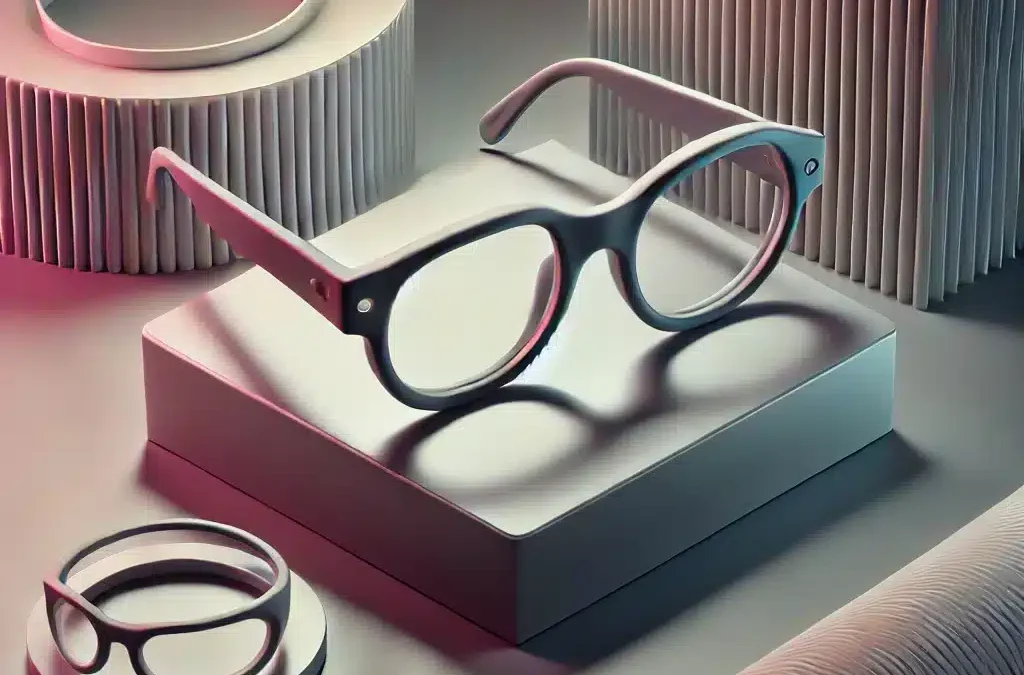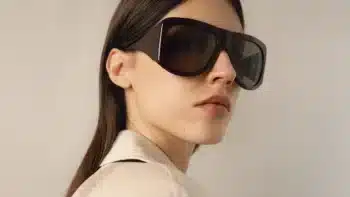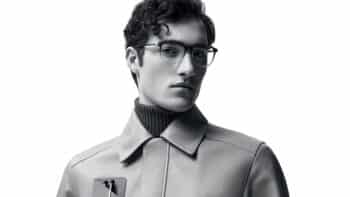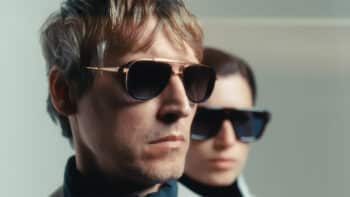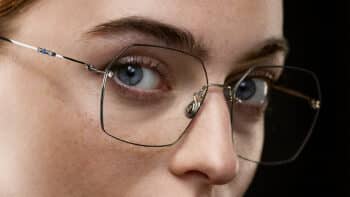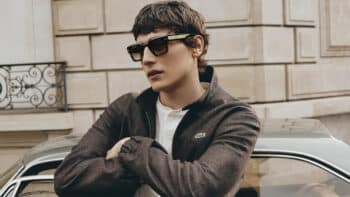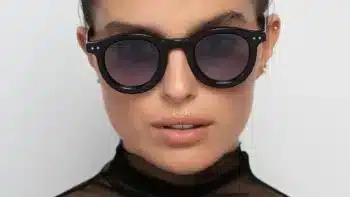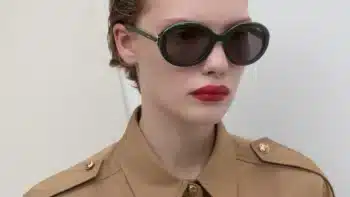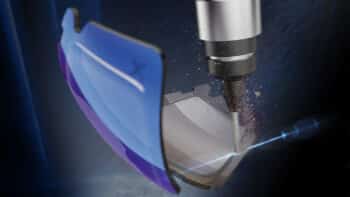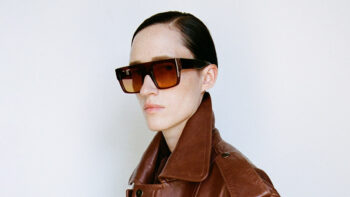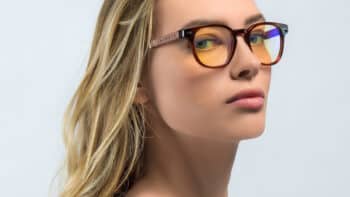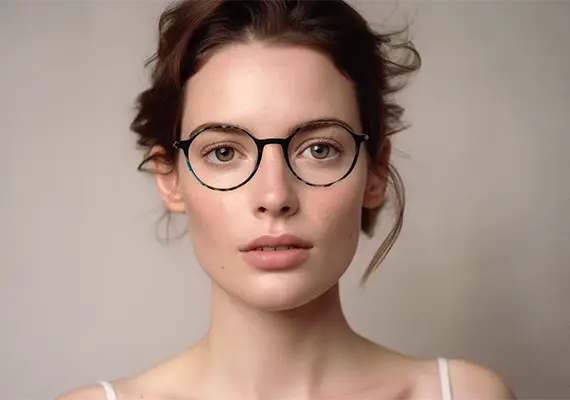Parisee -. : How did you become an eyewear designer? Can you summarize your journey?
E. Andrivet : I began my career in 1988 as an optician in Bordeaux. The store offered a repair service, and I quickly developed an interest in manufacturing and technical processes. I learned on the job, especially from a master craftsman who was a “Meilleur Ouvrier de France” (Best Craftsman in France) and worked with us.
Later, I moved to Paris around 1991 to become a store manager. At that time, the arrival of mutual health insurance systems completely transformed the optician profession. It shifted from a service-oriented role to a big business model, which didn’t resonate with me. I felt bored.
That’s when I started designing glasses, including a screwless model made from titanium wire. I pitched the idea to Maurice Timon, the founder of the Minima brand. He liked my project and bought my design for a good price. This encouraged me to pursue designing models for others. Despite challenges, I continued.
By 1994–1995, I had started exploring and training in 3D technology. This new process saved me significant time in proposing designs to brands.
Parisee -. : What are the major European brands you’ve collaborated with?
E. Andrivet : Over the past thirty years, I’ve worked with numerous brands such as Minima, Vincent Kaes (whose launch I contributed to), Zen Barcelona, Gold and Wood, Cartier, Boucheron, and Montblanc.
For every project, I visited factories to understand production processes, learn what was feasible, and determine costs.
Parisee -. : Tell me about your collaboration with Yohji Yamamoto. How much creative freedom do you have when working for such a prestigious fashion house?
E. Andrivet : I’ve been working with the brand for four years under a licensing agreement, and I enjoy total creative freedom without a specific brief.
Yohji Yamamoto’s collections often feature draped designs and strong influences from traditional Japanese culture.
For this collaboration, I immersed myself deeply in Japanese culture, especially theater, drawing inspiration from themes like cherry blossoms, swords, and kimonos. It resonated well!
Parisee -. : Can you describe a model from this collaboration that you’re particularly proud of?
E. Andrivet : I’ll mention two.
First, the “Look 1” model inspired by cherry tree roots, manufactured in a Japanese factory using a unique titanium injection process. It reinterprets the missel design. The root design starts at the hinge and progresses above the eyebrow. The result was outstanding, with three variations that became very successful.
The second is a series titled Looks 10/11/12. This series is hand-crafted from faceted acetate in Japan, where the acetate is cut like a diamond. Each hinge is unique—no two are the same, even the screws. Every part of the design was studied and crafted specifically for this collection. For this series, I drew inspiration from Japanese craftsmanship. The front design reflects traditional woodworking, while the metal armature resembles a Damascus sword.
Parisee -. : What inspires you when designing a new collection?
E. Andrivet : My main inspirations are Art Nouveau, naturalism, and mechanical parts, reflecting my passion for motorcycles and automobiles.
Parisee -. : How do you transition between brand identities? Does a part of you remain in each creation?
E. Andrivet : Brands ask me to retain my personality—that’s why they come to me.
With every new collaboration, I start by studying the brand’s history. Then I look for what I can bring to the table. The goal is to innovate without disrupting the essence.
Parisee -. : What characterizes your work?
E. Andrivet : One hallmark of my work is modeling a product directly from the vision in my mind onto my computer screen, bypassing preliminary sketches. Thanks to my experience, I know from this stage exactly how the glasses will be manufactured. This prevents me from wasting time on designs that aren’t feasible. Everything comes together simultaneously.
My drawings are always precise, with measurements and annotations, leaving no room for interpretation. Unlike the 2D sketches used by 95% of brands, 3D design eliminates ambiguity, saving time during manufacturing by focusing on material and process selection.
Parisee -. : How do you see eyewear design evolving in the near future?
E. Andrivet : Traditional manufacturing will continue for years but will increasingly coexist with the ever-advancing 3D printing.
3D printing offers significant advantages, including eco-friendliness by using only the necessary material, eliminating waste. It also provides creative freedom, enabling shapes that couldn’t be molded before.
In 2016, I founded Impressio, a brand exclusively offering 3D-printed designs. This manufacturing process is advancing rapidly, with a growing variety of materials.
Today, high-quality transparent materials are achievable. However, printing acetate—a highly prized material for its light-reflecting and emotional qualities—remains a challenge. Current materials feel cold, but within 5–6 years, resin advancements should bring us closer to acetate.
Parisee -. : You’re a pioneer in using 3D printing for eyewear. Can you elaborate on this new approach?
E. Andrivet : All major factories now have 3D printers for prototyping. This allows a prototype to be produced in five hours instead of 2–3 weeks using traditional methods. Manufacturers are also beginning to use this technology for small, intricate parts that are difficult to machine traditionally.
Additive manufacturing will gradually replace subtractive processes. Many brands already use 3D printing, such as incorporating cameras into the latest smart glasses.
3D printing also offers rapid turnaround times, opening promising possibilities in humanitarian efforts. I’m working on a project to create glasses on-site in impoverished or war-torn regions, where access to care is limited. With 3D printing, frames can be recreated within hours. Soon, printing lenses will also be possible. This field is advancing rapidly!
Parisee -. : What are the most memorable shapes in the history of eyewear design for you?
E. Andrivet : There are, on average, about thirty wearable lens shapes. Beyond that, designs tend to become odd, overly complex, and difficult to sell. Within this range, the focus should be on exploring the surrounding elements of the frames.
Currently, several creators are making fascinating artistic contributions to eyewear design. I’d particularly like to highlight the beautiful creations by VAO, Rigards, and Factory 900, as well as the leatherwork of Lucas de Staël.
Parisee -. : In your opinion, what defines ultra-high-end eyewear?
E. Andrivet : Today, ultra-high-end eyewear is represented by brands like VAO and Rigards, which I’ve already mentioned. Other examples include Lotos Eyewear, offering unique pieces crafted from solid gold or silver, Hoet Design with its printed titanium frames, and Alexanian’s one-of-a-kind solid gold designs.
Personally, I’ve also ventured into the ultra-high-end segment with the Andrivet brand. We create rare pieces, exclusively made-to-order, priced between 1,500 and 5,000 euros. These are exceptional designs that strive for product perfection.
